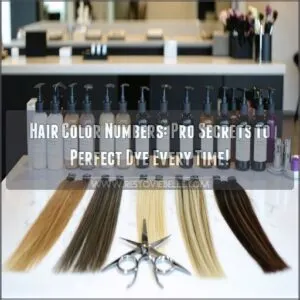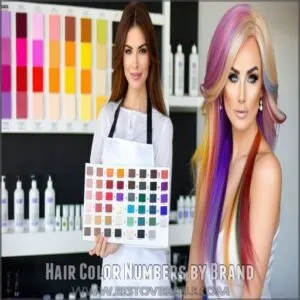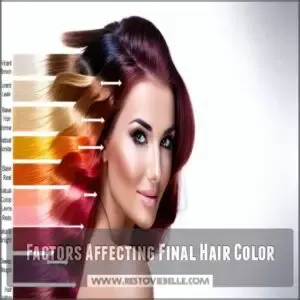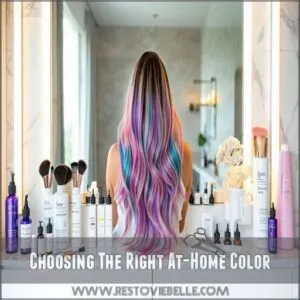This site is supported by our readers. We may earn a commission, at no cost to you, if you purchase through links.
 Cracking the code of hair color numbers is like having a secret weapon for your perfect shade! These digits aren’t just random – they’re your roadmap to hair color magic.
Cracking the code of hair color numbers is like having a secret weapon for your perfect shade! These digits aren’t just random – they’re your roadmap to hair color magic.
Level 1 means jet black, while level 10 screams platinum blonde. The first number tells you how dark or light you’re going, and those sneaky decimal points? They reveal hidden undertones that can make or break your look.
Matching within 3-4 levels of your current color minimizes damage and keeps things looking natural. Pro tip: your skin tone plays a starring role in choosing the right reflects and shades that’ll have everyone asking, "Who’s your colorist?
Table Of Contents
- Key Takeaways
- Hair Color Level System
- Hair Color Tones Explained
- Hair Color Reflects and Shades
- Hair Color Numbers by Brand
- Factors Affecting Final Hair Color
- Choosing The Right At-Home Color
- Frequently Asked Questions (FAQs)
- What do the numbers on hair color mean?
- What color number is my hair?
- Is a 4 or 5 darker in hair color?
- How do I choose my hair color number?
- Why does my hair color fade so quickly?
- Can I mix different hair color brands?
- How often should I touch up roots?
- Does hair color damage my natural hair?
- Will hair color work on gray hair?
- Conclusion
Key Takeaways
- You’ll decode your hair color with a level system ranging from 1 (jet black) to 10 (platinum blonde), where each number reveals your hair’s depth and potential for transformation.
- Understanding the decimal points in hair color codes will help you unlock subtle undertones that complement your skin tone and create a natural, flattering look.
- You’ll want to match your desired hair color within 3-4 levels of your current shade to minimize damage and achieve the most seamless, professional-looking results.
- Your skin’s undertones and natural pigmentation are crucial in selecting the right hair color, so you’ll need to consider factors like warmth, coolness, and your personal style when choosing your perfect shade.
Hair Color Level System
Ever wondered why hair color charts look like a numerical puzzle? The Color Intensity Scale is your roadmap to finding the perfect shade.
Hair color levels range from 1 (jet black) to 10 (platinum blonde), acting like a precision depth gauge for your strands. Think of it as a light meter for your locks – each number represents how much natural pigment gets stripped away.
Understanding the hair color levels is essential for achieving the desired shade, especially when trying to lift dark hair to a lighter tone. Pro stylists use this Level Conversion system to match your dream color without turning your hair into a crispy mess.
It’s not about aggressive bleaching, but strategically opening the hair cuticle to deposit color that looks natural and vibrant. Your complexion, eye color, and personal style all play into selecting the right hair color numbers that’ll make you shine.
Hair Color Tones Explained
Understanding hair color tones can feel like cracking a secret code. The numbers after the decimal point reveal your hair’s hidden personality – from cool ash browns (.1) to warm copper hues (.3). Your skin tone plays a starring role in this color drama. Exploring hair dye shades can help you make informed decisions about your hair color.
5 Pro Tips for Perfect Tone Matching:
- Cool, pinkish skin loves ash and gold shades
- Warm, peachy complexions rock caramel and beige
- Neutralize redness with strategic color selection
- Match undertones to create luminous hair color
- Consider your natural pigmentation for best results
Colorists are like hair color alchemists, mixing custom pigments that transform your look. They’ll help you navigate the intricate world of hair color tones, ensuring your new shade complements your unique beauty perfectly.
Hair Color Reflects and Shades
Your hair’s hidden color magic lies in reflects and shades – those subtle nuances that transform an ordinary dye job into a head-turning masterpiece.
Think of reflects like color whispers: warm tones expand and brighten, while cool tones add sophisticated depth. Gold, copper, and red create a sun-kissed glow, while ash and violet tones deliver sleek, smoky vibes.
Understanding the hair color basics is key for achieving the perfect shade. By understanding your hair’s natural color depth analysis, you’ll discover personalized shade matching that makes your hair look like it was kissed by a color genius.
Hair Color Numbers by Brand
Every hair dye brand has its own unique color numbering system that can feel like cracking a secret code, but don’t worry – you’ll soon be mastering these numerical mysteries like a pro.
Once you understand how brands like L’Oreal Professionnel map out their color levels and tones, you’ll be able to choose the perfect shade with confidence and precision.
L’Oreal Professionnel
After diving into hair color reflects, let’s explore L’Oréal Professionnel’s color wizardry. Their four-digit color system is a game-changer for personalized hair transformation:
- Salon colorists decode your unique features with precision
- Customized pigment mixing creates your perfect shade
- Virtual color testing helps you nail the look before commitment
L’Oréal’s color experts blend artistry and science, transforming hair color consultation into a customized experience. They’ve cracked the code of matching hues to your individual style, turning hair dye into a personal masterpiece that speaks volumes about your personality.
Other Brands
Building on L’Oreal’s approach, other hair color brands craft their own unique numbering symphonies. Imagine each brand as a different orchestra playing the same color melody, with slight variations in tone and depth.
Professional lines like Wella, Schwarzkopf, and Matrix have their own color level charts that speak a similar language. The first digit still signals your hair’s darkness or lightness, while additional numbers and letters dance around undertones and special effects.
Pro stylists know these color codes are like secret languages, helping you navigate from jet black to platinum blonde with precision. Want salon-worthy results? Learn to read between the numbers.
Factors Affecting Final Hair Color
Ever wondered why that trendy hair color you saw online doesn’t look exactly the same on you?
Your final hair color depends on a mix of factors like your current hair level, base tone, and natural undertones that can make or break your dye job.
Understanding Color Levels
Let’s break down the hair color level system and turn you into a dye-job pro.
Color depth charts are your roadmap to nailing the perfect shade, with levels ranging from 1 (jet black) to 10 (platinum blonde).
Think of the level system like a brightness slider – the higher the number, the lighter your hair.
Pro tip: always match your desired shade within 3-4 levels of your current color to minimize damage and guarantee a natural-looking result.
Mastering hair color numbers means revealing your hair’s true potential.
– Interpreting Tone Numbers
Explore the hair tone numbers, where each digit tells a vibrant story of color potential. These magical numbers reveal the hidden personality of your hair transformation.
- Violet tones neutralize unwanted redness
- Blue tones combat brassy yellows
- Green tones cancel out red and purple hues
- Beige tones soften color intensity
- Silver tones brighten and illuminate
Understanding hair dye numbers is essential for achieving the perfect hair color.
Pro colorists decode these tone numbers like artists, matching your unique features to the perfect shade. Whether you’re chasing warmth, cooling down brassiness, or adding dimension, understanding hair tone numbers is your secret weapon to achieving that head-turning, personalized color that screams "you".
– Personalized Consultation
Your hair color journey starts with a pro’s keen eye. A skilled colorist isn’t just mixing dye – they’re creating a personalized masterpiece customized to your unique features.
From skin undertones to natural hair color numbers, they’ll analyze every detail to craft a shade that elevates your look. To achieve this, understanding color consultation techniques is essential for a successful hair color service.
Virtual try-on tools are cool, but nothing beats expert hair analysis and color matching.
Choosing The Right At-Home Color
Ready to transform your hair color without the salon price tag?
Mastering at-home hair dye starts with understanding color levels and choosing the right shade that matches your natural hair tone and desired look.
Understanding Color Codes
Decoding hair color codes is like cracking a secret language that reveals your perfect shade. These numeric mysteries hold the key to your dream look:
- First digit: Base level blueprint
- Decimal digits: Tone’s hidden story
- Pigment nuances transform final color
- Professional insight trumps guesswork
- At-home color selection demands precision
Understanding the hair dye numbers is essential for achieving the desired hair color. Mastering Color Theory Basics transforms your Shade Matching game from guesswork to genius. Explore Hair Code Systems and watch your color confidence soar.
– Determining Natural Hair Level
Want to nail your perfect hair color? Think of your natural shade like a detective’s case file.
Grab a hair color chart and play matchmaker with your current hue. Pro stylists recommend comparing your strands against level numbers, tracking those subtle undertones that make your hair uniquely yours.
Hair Depth Analysis isn’t rocket science—it’s your color confidence blueprint, helping you understand your natural shade.
– Neutralizing Unwanted Tones
Into the wild world of hair color, tone correction is your secret weapon against unwanted warmth and brassy nightmares. Master the art of color balancing with these pro tips:
- Identify your current hair’s underlying tones
- Choose complementary neutralizing shades
- Target specific undertones with precision
- Use a color correction chart like a pro
Neutralize unwanted tones by selecting opposite hues on the color wheel. Whether you’re battling brass or chasing that perfect neutral shade, strategic color correction transforms your hair from "meh" to magnificent. Utilizing a brassy tone remover can be an effective method to eliminate unwanted warm tones from your hair.
Frequently Asked Questions (FAQs)
What do the numbers on hair color mean?
Hair color numbers tell you how light or dark a shade is, from 1 (black) to 10 (lightest blonde).
They help you pick the perfect tone that’ll make your hair color pop and match your style perfectly.
What color number is my hair?
Determine your hair color number by comparing your natural shade to a professional color chart.
Typically ranging from 1 (black) to 10 (lightest blonde), these numbers help you pinpoint your exact hair depth and tone.
Is a 4 or 5 darker in hair color?
When picking hair color, level 4 sits darker than level
Think of it like climbing down a shade ladder – the lower the number, the deeper the color.
You’ll want level 4 for a richer, more intense brown tone.
How do I choose my hair color number?
Ever wondered how to nail your perfect hair color?
Match your current shade within 3-4 levels, consider your skin’s undertones, and consult a pro stylist for a color that’ll make heads turn and boost your confidence.
Why does my hair color fade so quickly?
Your hair color fades fast because of sun exposure, frequent washing, heat styling, and low-quality dye.
Swimming and hard water strip color molecules, leaving your locks looking dull and lackluster before their time.
Can I mix different hair color brands?
Mixing different hair color brands isn’t recommended. Chemical compositions vary, potentially causing unpredictable results, uneven color, or hair damage. Stick to one brand for consistent, safe, and professional-looking color application.
How often should I touch up roots?
Like roots breaking through concrete, hair color grows out revealing your natural shade.
Touch up every 4-6 weeks to keep your color looking fresh and seamless, depending on your hair growth rate and color contrast.
Does hair color damage my natural hair?
Yes, hair color can damage your hair if not done carefully.
Harsh chemicals strip proteins, causing dryness and breakage.
Choose quality products, use deep conditioning treatments, and limit color treatments to minimize potential damage.
Will hair color work on gray hair?
Gray hair’s a rebel that screams for special attention!
You’ll need permanent hair color with higher developer volumes to conquer those stubborn silver strands.
Professional colorists recommend specific formulas that penetrate resistant gray hair more effectively.
Conclusion
Knowledge is power, and mastering hair color numbers is your ticket to salon-worthy results.
You’ve learned the insider secrets to decoding those tricky digits. Whether you’re going DIY or consulting a pro, understanding hair color levels and tones will help you nail your perfect shade.
Trust the system, respect your natural color, and don’t be afraid to experiment. With these hair color numbers in your arsenal, you’ll transform your look with confidence every single time.









